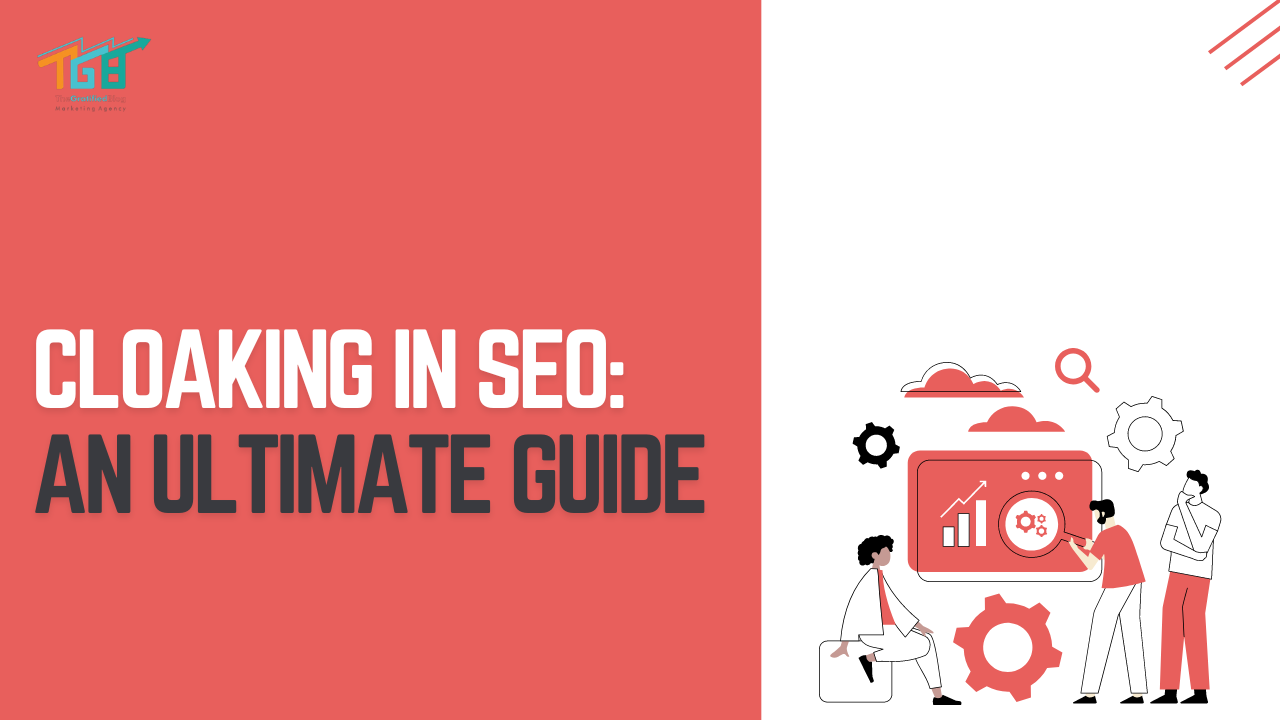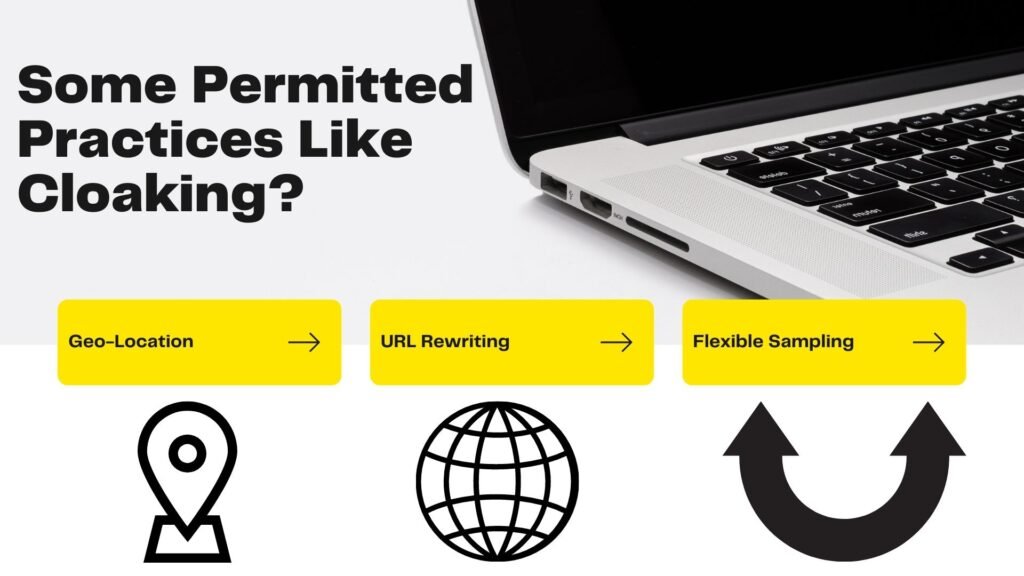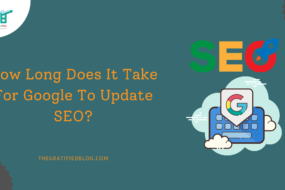
Do we all want our websites to rank higher on search engine results pages? Many strategies and tactics can be implemented to achieve it.
Such as optimizing website content, building links to your site, etc.
However, this process can be time-consuming and complex, and people often don’t wait for so long to get results.
They use other techniques like cloaking to get better search engine rankings more quickly.
This article discusses what cloaking in SEO is, its standard practices, its risks and consequences, and much more.
What Is Cloaking In SEO?
Cloaking is a technique used to influence search engine rankings by displaying content that differs from the content seen by search engines to users.
To improve search engine rankings, website owners use this technique to rank for particular keywords that they find challenging to rank quickly.
However, it comes with risks because search engines have a significant issue with this practice, as it can be used to get around their ranking algorithms.
Also, they have a sophisticated algorithm that can detect and penalize sites that cloak, which can result in not indexing pages and may even ban your site from the search engine.
What Are A Few Examples Of Cloaking Techniques?
In SEO, cloaking can manifest in various ways; here are some examples of popular cloaking practices:
Implementing Hidden Text
Some website owners try to cloak by using hidden text on their pages to improve their rankings.
It can involve placing keyword-rich text in the background of a webpage or making the text invisible through CSS styling.
Which is readable by search engines but not by humans.
User Agent Cloaking
User-agent cloaking is when a website displays different content to different users based on their user agent.
It is done to cater to different audiences and improve rankings.
For example, users who visit your site with a mobile device are typically shown one version of your content.
While users visiting with desktop devices could see another version.
IP Cloaking
In this technique, website owners display different content to users based on their IP addresses.
For example, someone with a US IP address may be shown one content page.
While someone visiting from another country could see an entirely different version of the same webpage.
This technique can help improve rankings by allowing site owners to target specific audiences.
HTTP Accept-Language Cloaking
In this method, website owners try to identify a user’s location based on their language preferences.
Or use other details in the HTTP request headers.
For example, if a visitor is identified as being from Germany. They might be shown content that caters specifically to Germans.
It can improve rankings by targeting specific audiences and catering to their needs to increase user engagement and improve search engine rankings.
JavaScript Cloaking
This technique involves creating a webpage with JavaScript code that dynamically instructs the browser.
Or load different content based on specific criteria.
For example, suppose a site visitor has been identified as being from a particular country.
In that case, the site could use JavaScript to detect their location and display content that is different from someone visiting another country.
Hiding Flash-Based Pages
Another common cloaking practice involves creating a website primarily based on Flash or multimedia content.
To increase their rankings, some site owners will hide the flash-based pages so that search engines only index text-based versions.
It can improve rankings by presenting a more user-friendly site version to visitors while hiding less relevant content.
Why Should You Avoid Cloaking in SEO?
Several potential risks are associated with cloaking in SEO, including :
You Could Be Penalized
Search engines are susceptible to cloaking practices, and even minor instances can result in penalties for search results.
Once that happens, it can be challenging to recover from the penalty, and your site may struggle to rank well for months or years.
Your Site Could Be Banned
In some cases, entire websites have been banned from search results for using cloaking tactics, which can negatively impact traffic and revenue.
Also, it can be challenging to recover from a ban and regain search engines’ trust.
You’ll Almost Certainly Get Caught
It is challenging to cloak in a way that goes undetected by search engines,
At some point, you will likely get caught using these techniques.
It Can Damage Your Brand
It can also hurt your brand reputation, as users may perceive you as untrustworthy or dishonest if they suspect you are using cloaking tactics to manipulate search results.
How Do You Determine If A Site Is Closing?
Several different methods can be used to determine if a site is cloaking. These may include :
- Compare The Preview Text To The Page
A straightforward way to check for cloaking is by comparing the preview text shown in search results to the actual content on the page.
If these do not match, it may indicate that cloaking is being used.
- Submit The URL To A Cloaking Checker
Another common technique is to submit the URL of a page suspected. Check it with a cloaking checker tool like Sitechecker, etc.
These tools can analyze the site and provide information on whether it contains cloaking and other black hat tactics.
What Are Some Permitted Practices Like Cloaking?

Some acceptable practices involve similar tactics to cloaking, such as:
Geo-Location
It automatically redirects users based on their geographic location to show them content relevant to their location.
URL Rewriting
This practice involves dynamically changing the URLs of web pages to customize the page content for different users or search engines.
Flexible Sampling
It involves sampling techniques in analytics software to obtain accurate visitor data and traffic patterns, even if you have a relatively small sample size.
Cloaking FAQ
Q1. Is Cloaking Good For SEO?
It can yield both favorable and adverse consequences. Cloning helps increase traffic and ranking by hiding spammy content from search engines.
In contrast, others believe it can be detected and penalized by search engines, reducing traffic and rankings.
Q2. How Do I Stop Cloaking?
To stop cloaking, you should first evaluate any potential cloaking practices affecting your site and work to remove them.
It may involve using any tool to cut down the manual process.
Additionally, it’s crucial to implement effective spam policies to ensure that search engines do not see your site as suspicious. Some examples include avoiding the aggressive use of keywords and links and spammy tactics like keyword stuffing or excessive link building.
Q3. Is Cloaking A Black Hat SEO Practice?
Well, it comes under black hat SEO techniques that can be employed for manipulating search engine rankings or presenting users with misleading information and content.
However, whether or not you choose to use cloaking in your SEO strategy depends on your individual goals.
Conclusion
I hope you understand the role of cloaking in SEO and its potential risks and benefits.
If you are starting your journey to understand more about this topic or looking for ways to stop this strategy, these steps could be helpful.
If you have doubts about cloaking SEO or need help with your current strategy, please contact us today. We will be happy to help you.
Thanks for reading 🙂








No Comments